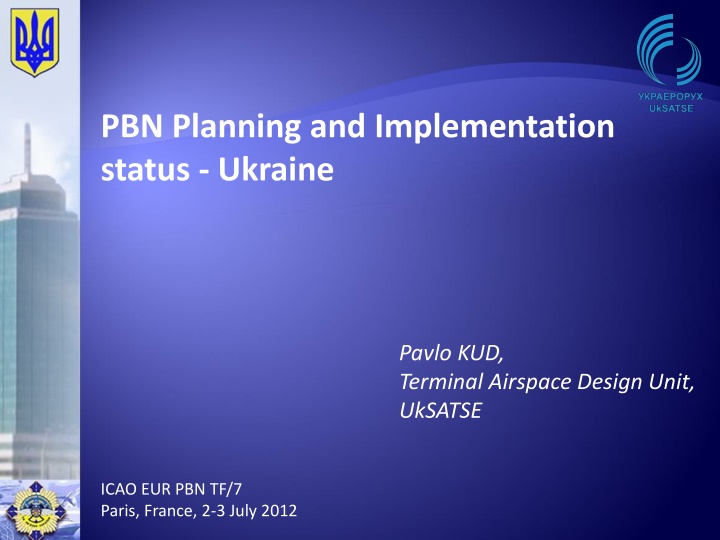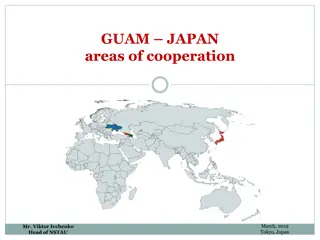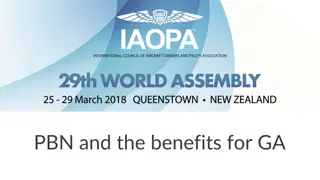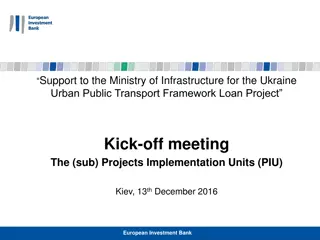PBN Planning and Implementation Status in Ukraine
The PBN Planning and Implementation status in Ukraine involves initiatives such as the implementation of Precision Area Navigation (P-RNAV) and Approach Procedures with Vertical Guidance (APV). Ukraine is working on national RNAV1 implementation for standard instrument procedures at various aerodromes. Major infrastructure upgrades, including new runways, terminals, and ATC systems, were carried out in preparation for the EURO 2012 event. The State Aviation Administration of Ukraine established a national task force for PBN implementation, including stakeholders from various aviation entities. The European Union's Twining Project supports Ukraine in integrating into the Trans-European Transport Network, with a focus on delivering the National PBN Implementation Plan.
Download Presentation

Please find below an Image/Link to download the presentation.
The content on the website is provided AS IS for your information and personal use only. It may not be sold, licensed, or shared on other websites without obtaining consent from the author.If you encounter any issues during the download, it is possible that the publisher has removed the file from their server.
You are allowed to download the files provided on this website for personal or commercial use, subject to the condition that they are used lawfully. All files are the property of their respective owners.
The content on the website is provided AS IS for your information and personal use only. It may not be sold, licensed, or shared on other websites without obtaining consent from the author.
E N D
Presentation Transcript
PBN Planning and Implementation status - Ukraine Pavlo KUD, Terminal Airspace Design Unit, UkSATSE ICAO EUR PBN TF/7 Paris, France, 2-3 July 2012
Formal basis ICAO 36thICAO Assembly: Resolution A36/23 has been agreed Resolution A36/23 was superseded in 2010 by the 37thICAO Assembly Resolution A37/11: EUROCONTROL Local Single Sky ImPlementation (LSSIP) Plan - Ukraine (previously known as LCIP) document: - NAV03: Implementation of Precision Area Navigation RNAV (P-RNAV); - NAV10: Implement Approach Procedures with Vertical Guidance (APV). National Precision area-navigation (RNAV1) implementation for standard instrument departures and arrivals procedures is envisaged by Ukraine Airspace Use State System Development Program for 2010-2014 (Ukraine Cabinet enactment under 13/01/2010 44) for KYIV/Boryspil , Kharkiv, Donets k, Simferopol , L viv, Odesa and Dnipropetrovs k aerodromes. 2
EURO 2012 Context Huge reconstruction of ground infrastructure 2 new runways in Donetsk and Kharkiv (with new ILS equipment, mostly ILS/DME, new automated ATIS installations (2 frequencies 2 languages) 4 new TWRs for KYIV/Zuliany, Donets k, L viv and Kharkiv 5 new terminals for KYIV/Borispil ( F - 2011, D 2012), KYIV/Zuliany, Donets k, L viv and Kharkiv (with new aprons and taxiways) 1 new DVOR/DME position & 3 new DME positions in KYIV TMA ATC systems upgrade New ATC systems New ATC procedures Simultaneous Operation on Parallel Runways (SOIR) RNAV Departures RNAV Arrivals 3
SAA Activity on PBN Implementation Order Jan, 13 2010 #11 established national TF: Ukraine PBN taskforce: State Aviation Administration of Ukraine Ukrainian State Air Traffic Service Enterprise Aerosvit & Ukraine International Airlines KYIV/Borispil International Airport National Aviation University Antonov Design Bureau Meetings every two months Few seminars took place for awareness company purpose The European Union s Programme for Ukraine Twining Projects - Support to the Integration of Ukraine in the Trans-European Transport Network TEN-T Deliverable: National PBN Implementation Plan UKRAINE Lively Document, current version 0.9 4
PBN TF Decisions Outcomes of first two meetings (2011): - implementation of PBN in Ukraine terminal airspace according to RNAV 1 specification (former P-RNAV) is foreseen; - use of GNSS navigation infrastructure and DME/DME coverage as far as possible and as a backup; - implementation milestones for departure & arrival operations are: Kyiv/Boryspil pilot project; Dnipropetrovs k, Kharkiv, Donets k, L viv, Simferopol , Odesa by the end of 2012; - planning of approach with vertical guidance procedures implementation (APV) after 2012 (delay connected with EGNOS coverage limitations). 5
PBN Implementation Planning Principles Three areas of applicability En-Route Airspace Terminal Airspace Approach Operations Three time perspectives Short-Term (now 2015) Medium-Term (2015 2020) Long-Term (2020+) Regular Revision by National PBN TF Twice a year Consultation It was decided to upload National PBN Plan to the official SAA of Ukraine website as soon as it s officially published The draft of the plan was submitted to ICAO for commenting 6
PBN Implementation Planning - Enroute Area of applicability Short-Term (Now 2015) Medium-Term ( 2015- 2020) Long-term (2020+) Continental enroute RNAV 5 RNAV 1 A-RNP Short-term RNAV spec. RNAV 5 Year Medium-Term RNAV spec. + RNAV 1 Year Long-term RNAV spec. A-RNP Year FIRs 2016* t.b.d. Kyiv FIR RNAV 5 + RNAV 1 2016* A-RNP t.b.d. L viv FIR RNAV 5 + RNAV 1 2016* A-RNP t.b.d. Odesa FIR Simferopol FIR RNAV 5 + RNAV 1 2016* A-RNP t.b.d. Dnipropetrovs k FIR RNAV 5 + RNAV 1 2016* A-RNP t.b.d. *Tentative 7
PBN Implementation Planning - Terminal Airport Short-term Year Medium-term Year Long-term Year 1stQua 2012 Kyiv/Borispol` RNAV 1 introduction RNAV 1 mandatory Introduction of A-RNP RNAV 1 mandatory 2016 A-RNP mandatory t.b.d. 2016 L viv RNAV 1 introduction Mid 2012 1stQua 2012 2017* Introduction A-RNP t.b.d. Donets k RNAV 1 introduction RNAV 1 mandatory 2017* Introduction A-RNP t.b.d. Dnipropetrovs k RNAV 1 introduction Mid 2012 RNAV 1 mandatory 2018* Introduction A-RNP t.b.d. Kharkov RNAV 1 introduction Mid. 2012 RNAV 1 mandatory 2018* Introduction A-RNP t.b.d. Odesa RNAV 1 introduction End 2012 RNAV 1 mandatory 2018* Introduction A-RNP t.b.d. Simferopol RNAV 1 introduction End 2012 RNAV 1 mandatory 2018* Introduction A-RNP t.b.d. *Tentative 8
PBN Implementation Planning Approach (1) Classification of aerodromes (37): High traffic density, being mainly international operations KYIV (Boryspil`) [UKBB] (1) Medium traffic density, being mainly international operations Dnipropetrovs k [UKDD], Donets k [UKCC], Kharkiv (Osnova) [UKHH], KYIV (Zhuliany) [UKKK], L viv [UKLL], Odesa [UKOO], Simferopol [UKFF] (7) Low traffic density / domestic Chernivtsi [UKLN], Ivano-Frankivs k [UKLI], Luhans k [UKCW], Mariupol [UKCM], Mykolaiv [UKON], Rivne [UKLR], Uzhhorod [UKLU], Vinnytsa (Gavryshivka) [UKWW], Poltava [UKHP], Sevastopol (Bel bek) [UKFB], Sumy [UKHS] (11) Cargo Operations/Test Flights Kryvyi Rih (Lozuvatka) [UKDR], KYIV (Antonov-1) [UKKT], KYIV (Antonov-2) [UKKM], Lymans ke [UKOM], Dzhankoi [UKFY], Kirovohrad [UKKG], Kremenchuk (Velyka Kokhnivka) [UKHK], Kharkiv (Sokolnyky) [UKHD], Zaporizhzhia (Mokraya) [UKDE] (9) GA/Sport/AFIS (in accordance to AIC A 08/11 effective 16 DEC 2011) Cherkasy [UKKE], Kerch [UKFK], Khmel'nyts'kyi [UKLH], Ternopil [UKLT], Berdians'k [UKDB], Simferopol (Zavods'ke) [UKFW], Zhytomyr (Ozerne) [UKKO], Severodonets'k [UKCS], Kherson [UKOH] (9) 9
PBN Implementation Planning Approach (2) Airport Type Short-term 2011 2015 Introduction RNAV NPA and APV Baro-RNAV Medium-term 2015 - 2020 APV SBAS I Long-term 2020+ APV SBAS II International airport High traffic density International airports Medium traffic density Domestic airports Low traffic density Cargo & Business airports Low traffic density GA/Sport/AFIS Implementation dependent on the level of aircraft NAV equipage (present and future) operating to/from the specific airport. Introduction RNAV NPA Introduction APV Baro-RNAV APV SBAS I & II Introduction RNAV NPA APV Baro-RNAV Introduction RNAV NPA APV SBAS I Introduction APV Baro-RNAV APV SBAS I N/A N/A N/A 10
PBN Implementation current state (1) Mostly inspired by UkSATSE due current challenges Increasing percentage of modern aircraft Capacity requirements Outdated NDB infrastructure Less cockpit & ATCo workload Aeronautical Information Circular (AIC 05/11 dated 10 November 2011) in which RNAV1 (P-RNAV) is being introduced in the TMA s of 7 international aerodromes in 2012. Considerations: Altitudes are not less than MSA Radar Coverage DME/DME Coverage RNAV 1 Departures & Arrivals only RNAV 1 Arrival procedures connected to ILS final approach (trombone) 11
PBN Implementation current state (2) Enroute Due to local regulation for GNSS operations to be supported with DME/DME coverage as a back-up infrastructure RNAV 5 (B-RNAV) currently introduced in all Ukrainian FIRs above FL275 Terminal Kyiv TMA Donets k TMA AIRAC AMDT 04/12 EFF 31 MAY 2012 AIRAC AMDT 04/12 EFF 31 MAY 2012 Knarkiv TMA AIRAC AMDT 03/12 EFF 03 MAY 2012 Dnipropetrovs k TMA AIRAC AMDT 05/12 EFF 23 AUG 2012 L viv TMA AIRAC SUP 02/12 EFF 03 MAY 2012 Odesa TMA by the end of 2012 Simferopol TMA by the end of 2012 12
PBN Implementation current state (3) RNAV 1 in Terminal Airspace Activity 3 Implementation Plans for RNAV 1 Introduction: (KYIV Pilot Project, Eastern Region (3 aerodromes), L viv. National Safety Case has been done for Pilot RNAV 1 Project Training program & Training of ATCos Ground & Flight Validation SAA Decision (Order Marh, 30, 2012 #258) 1200 m (4000 ) 13
Post Implementation Monitoring ATCos Point of view Less RT workload & Less Vectoring Direct-To Function Predictable Manoeuvres Transition to final technique followed by ILS strait-in approach is respected Crews Point Of View FMS controlled Flights Shortcuts are not always advantages (clearances for longer waypoints sequence are well appreciated) Expect RNP approaches after RNAV 1 arrival to be able to fly in a seamless environment
Further Activity Airlines started to change their passive position in term of RNAV & RNP introduction due to requirements to comply this specification in different European states Introduction of best equipped best served principle EGNOS unavailability Bilateral-meeting between SAA of Ukraine & EC, last spring, Kiev More DMEs to be installed Upgrade a flight laboratory to validate SBAS/Baro APV approaches 15
Lessons Learned Difficulty with bi-lingual version It s the only way ahead to have National PBN Implementation plan as a living document, which has to be updated on a regular basis. Following to this conclusion It s not always easy task to support both versions of the National PBN Implementation plan: On one hand you have to provide English version for wide aviation community On the other hand you have to provide up-to-date version in Ukrainian due to institutional issues ANSP & Airlines different understanding After assessment it was observed that airlines not always understand the difference between pre-PBN understanding of PBN. Many of airline experts were surprised with completely new content of ICAO document with the same number (9613) Two absolutely different ICAO documents (9613): Many AFM contain a performance table with RNP value. Airlines often consider this RNP value as an airworthiness (and even operational approval) for RNAV & RNP specification. Resource limitations SAA experts involved in many different activities and very busy, it s not always possible to keep the same person in PBN TF; the same for airlines. Therefore ANSP becomes the driven force for PBN implementation DME/DME coverage New DMEs deployment is usually an upgrade of conventional navigation infrastructure. Fortunately, the configuration of conventional navaids was surprisingly good even for RNAV applications in KYIV TMA 16
Lessons Learned Institutional issues In contrast to European states (EASA) certification and operational approval has to be provided by national CAA. Currently TGL 10 rev 1. GPS and GLONASS The recognition of GPS (or GLONASS) to be the primary mean of navigation 17























